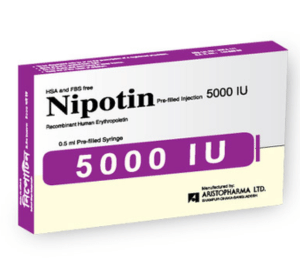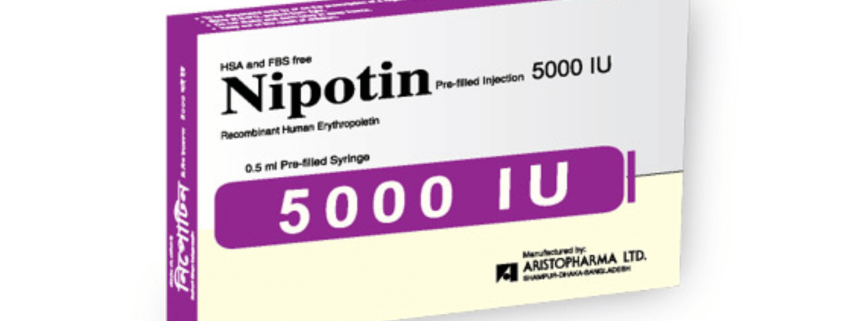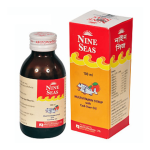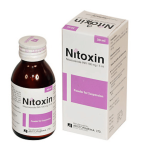Nipotin (Erythropoietin)

Therapeutic Group : Biotech
Presentation:
Nipotin 2000 Injection: Each 0.2 ml Pre-filled Syringe contains Erythropoietin concentrated solution (rDNA) BP 2000 IU.
Nipotin 3000 Injection: Each 0.3 ml Pre-filled Syringe contains Erythropoietin concentrated solution (rDNA) BP 3000 IU.
Nipotin 4000 Injection: Each 0.4 ml Pre-filled Syringe contains Erythropoietin concentrated solution (rDNA) BP 4000 IU.
Nipotin 5000 Injection: Each 0.5 ml Pre-filled Syringe contains Erythropoietin concentrated solution (rDNA) BP 5000 IU.
Nipotin 10000 Injection: Each 1 ml Pre-filled Syringe contains Erythropoietin concentrated solution (rDNA) BP 10000 IU.
Indications:
Nipotin is indicated in the following conditions:
Treatment of anemia due to-
-Chronic Kidney Disease (CKD) in patients on dialysis and not on dialysis.
-The effects of concomitant myelosuppressive chemotherapy and upon initiation, there is a minimum of two additional months of planned chemotherapy.
-Zidovudine treated HIV-infected patients Reduction of RBC transfusions in patients undergoing surgery.
Dosage & Administration:
Treatment of anemia in chronic renal failure:
Nipotin should be administered intravenously or subcutaneously in patients with renal insufficiency or chronic renal failure. In patients maintained on hemodialysis, Nipotin should always be administered after completion of dialysis.
Adults:
For patients with CKD on dyalysis: The recommended starting dose of Nipotin (rch) is 50-100 IU/kg, three times per week administered over 1-5 minutes. For hemodialysis patient, intravenous route of administration is preferred.
For patients with CKD not on dialysis: The recommended starting dose of Nipotin (rch) is 50-100 IU/kg, three times per week, administered as I.V. or S.C. injection over 1-5 minutes.
Further dose increments should depend upon the initial response (proposed rate < 20 g/l per month). Because of the length of time required for erythropoiesis – several days for erythroid progenitors to mature and be released into the circulation – a clinically significant increase in haematocrit is usually not observed in less than 2 weeks and may require up to 6 weeks in some patients. If required, dose increments in steps of 25 IU/kg in intervals of four weeks are recommended. If the rate of haemoglobin (Hb) rise exceeds 20 g/l per month at 50 IU/kg, three times per week, downward dosage adjustments should be made in the amount administered in each dose and by omitting one of the weekly doses. Similar downward dose adjustments should be made if the Hb level exceeds 120 g/l. Maximum dose should generally not exceed 200 IU/kg 3 times per week. When a target haemoglobin concentration of 100-120 g/l has been achieved, maintenance dose should be individualized for each patient. In patients undergoing dialysis, the median maintenance dose is 75 IU/Kg, three times a week, with a range from 12.5 to 525 IU/kg three times a week as directed by the physician. In CRF patients not on dialysis, maintenance dose is 75 to 150 IU/kg per week.
Children:
For pediatric hemodialysis patients:
The treatment is divided into 2 stages:
Correction phase:
50 IU/kg 3 times per week by the intravenous or subcutaneous route. When a dose adjustment is necessary, this should be done in steps of 25 IU/kg 3 times per week at intervals of at least 4 weeks until the desired goal is achieved.
Maintenance phase:
Appropriate adjustment of the dose should be made in order to maintain the haemoglobin concentration within the desired range between 92-105 g/l. Generally, children less than 30 kg require higher maintenance doses than children over 30 kg and adults.
For pediatric patients not on hemodialysis: 75 to 150 IU/Kg per week.
Treatment of anemia in cancer patients on chemotherapy:
Starting dose: Adult: 150 IU/kg 3 times per week by S.C. routes. Pediatric: 25 to 300 IU/kg 3 to 7 times per week by S.C. or I.V. route.
Dose adjustment: If the response is not satisfactory, the dose should be increased by 300 IU/kg 3 times per week. If the hematocrit exceeds 40%, the dose should be stopped until the hematocrit falls to 36%. The dose should be reduced to 25% when treatment is resumed & titrated to maintain the desired hematocrit.
Surgery patients:
The recommended dose is 300 IU/kg/day subcutaneously for 10 days before surgery, on the day of surgery, and for 4 days after surgery. An alternate dose schedule is 600 IU/kg subcutaneously in once weekly dose (21, 14, and 7 days before surgery) plus a fourth dose on the day of surgery.
Zidovudine-treated HIV-infected patients
Starting dose:
Adult: 100 IU/kg as an I.V. or subcutaneous injection thrice in a week (TIW) for 8 weeks.
Pediatric: 50 to 400 IU/kg 2 to 3 times per week by subcutaneous or I.V. route.
Dose adjustment: If the response is not satisfactory, the dose should be increased by 50-100 IU/kg thrice in a week (TIW). Response should be evaluated every 4 to 8 weeks thereafter and the dose adjusted accordingly by 50 to 100 IU/kg increments thrice in a week (TIW).
Maintenance dose: The dose is titrated to maintain the hematocrit between 33-36%.
Instructions for injection:
Parenteral medicine products should be visually inspected for particulate matter and discoloration prior to administration. Product exhibiting particulate matter or discoloration must not be used. Do not shake, as shaking may denature the glycoprotein, rendering it inactive.
Administer as I.V. or S.C. injection over 1-2 minutes. In patients on dialysis the injection should follow the dialysis procedure. Slow injection over 5 minutes may be beneficial to those who experience flu-like symptoms. For subcutaneous dosing a maximum volume of 1 ml at any one injection site should not be exceeded. In the case of larger volumes, the injection should be divided between more than one site.
Do not dilute or transfer to any other container. Do not administer by intravenous infusion or in conjunction with other medicine solutions.
Contrainidications:
Erythropoietin should not be used in patients with-
-Uncontrolled hypertension.
-Pure red cell aplasia that begins after treatment with Erythropoietin or other Erythropoietin protein drugs.
-Serious allergic reactions to Erythropoietin.
-Use of the multi-dose vials in neonates, infants, pregnant women, and nursing mothers.
Warning & Precautions:
Myocardial infarction, stroke, and thromboembolism: Using erythropoietin to target a hemoglobin level of greater than 1.1 g/l increases the risk of serious adverse cardiovascular reactions and has not been shown to provide additional benefit. Use caution in patients with coexistent cardiovascular disease and stroke.
Increased mortality and/or increased risk of tumor progression or recurrence in patients with cancer, hypertension: Control hypertension prior to initiating and during treatment with erythropoietin.
Seizures: erythropoietin increases the risk for seizures in patients with CKD. Increase monitoring of these patients for changes in seizure frequency or premonitory symptoms.
Pure red cell aplasia (PRCA): If severe anemia and low reticulocyte count develop during erythropoietin treatment, withhold erythropoietin and evaluate for pure red cell aplasia (PRCA).
Side effects:
The most common side effects during treatment with erythropoietin are myocardial infarction, stroke, and thromboembolism, increased mortality and/or increased risk of tumor progression or recurrence in patients with cancer, hypertension, seizures, serious allergic reactions etc.
Drug interaction:
There are no known clinically significant medicine interactions, but the effect of erythropoietin (rch) may be potentiated by the simultaneous therapeutic administration of a haematinic agent. Drugs that decrease erythropoiesis may decrease the response to erythropoietin (rch).
Use in special groups:
Pregnant woman: There are no controlled studies of erythropoietin in pregnant women. Therefore, erythropoietin should be used during pregnancy only if erythropoietin is clearly needed.
Nursing mothers: It is not known whether this drug is excreted in human milk. Because many drugs are excreted in human milk, caution should be exercised when erythropoietin is administered to a nursing woman.
Packing:
Nipotin 2000 Injection: Each pack contains 1 pre-filled syringe of recombinant erythropoietin 2000 IU/0.2 ml in blister pack.
Nipotin 3000 Injection: Each pack contains 1 pre-filled syringe of recombinant erythropoietin 3000 IU/0.3 ml in blister pack.
Nipotin 4000 Injection: Each pack contains 1 pre-filled syringe of recombinant erythropoietin 4000 IU/0.4 ml in blister pack.
Nipotin 5000 Injection: Each pack contains 1 pre-filled syringe of recombinant erythropoietin 5000 IU/0.5 ml in blister pack.
Nipotin 10000 Injection: Each pack contains 1 pre-filled syringe of recombinant erythropoietin 10000 IU/1 ml in blister pack.



